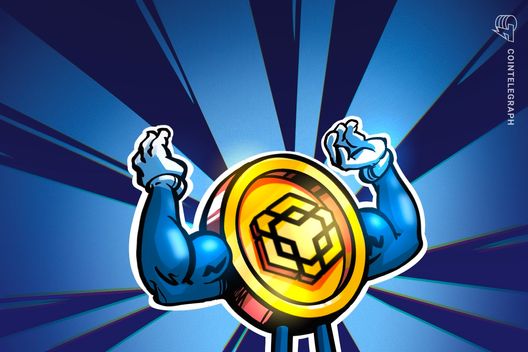
Kryptowährungen fallen zum Start in die neue Woche deutlich. Dieser Fakt macht jedoch Hoffnung für Bitcoin:

Krypto minen, NFT minten, Gold schürfen und Geld drucken

Kryptowährungen fallen zum Start in die neue Woche deutlich. Dieser Fakt macht jedoch Hoffnung für Bitcoin:
Binance has announced an incentives program for Ethena’s stablecoin, offering users a lucrative opportunity to earn returns by holding USDe.
The official announcement details how the platform will calculate the rewards, distribution, and participation requirements.
Notably, Binance confirmed a limited-time promotion to sweeten the deal, offering eligible holders a 12% APR (annual percentage rate).
During the Promotion Period, users who hold a minimum of 0.01 USDe in their Binance account(s) for at least 24 hours will be eligible to earn rewards at the increased 12% APR.
Earn 12% APR with USDe on Binance Earn!
Hold USDe to get daily rewards, trade anytime, and use as collateral.
Start from just 0.01 USDe – no max limit!
Know more 👉 https://t.co/gKzG7hWleG pic.twitter.com/tDRo7uJcUB
— Binance (@binance) September 22, 2025
The one-month promotion runs between September 22 and October 21, and could see stablecoin enthusiasts interact with one of the highest passive-earning opportunities.
Ethena’s USDe has seen massive traction lately. It remains unique from established projects like USDT and USDC in different ways.
USDe isn’t a fiat-backed asset. While USDT and USDC are dollar-pegged, Ethena’s is a digital dollar leveraging special strategies and crypto backing for stability.
USDe leverages delta-hedged positions in stable assets, including BTC and ETH.
Also, it has attracted attention due to its yield-bearing features, allowing individuals to earn from their idle stablecoins.
USDe has quickly dominated the spotlight as the top non-fiat-backed USD-denominated cryptocurrency.
DeFiLlama data shows it boasts over $14.076 billion in circulating supply, and around $14.104 billion in market cap.

The USDe incentive program reflects Binance’s dedication to attracting and retaining users through passive income.
With yield-bearing assets gaining traction, the exchange is positioning itself as a leading platform for lucrative earnings.
Meanwhile, USDe holders will take the promotion as an opportunity to earn from the balances with minimal effort.
The move also signals Binance’s conviction in Ethena’s future and growing influence with DeFi and CeFi.
The rewards are straightforward and aim to incentivize loyal holders, and not speculators.
Individuals start earning automatically once they hold more than 0.01 USDe in Funding, Margin, or Spot accounts.
Users will enjoy 8% APR, but the figure remains at 12% APR during the 1-month promotion period.
Meanwhile, the exchange will take multiple snapshots during the day to determine minimum balances and guarantee fair calculations.
Holding USDe is the only requirement.
Users can purchase the stablecoin through the Spot market and enjoy fee-free USDE-USDT through December 22.
Users with small and massive balances can leverage Binance’s USDe earn program, as there’s no limit on holdings.
However, it’s crucial to check your region’s eligibility.
Binance has cautioned that individuals in restricted areas like Canada, the EU, Japan, the US, and Australia cannot participate.
Ethena’s native coin trades at $0.6017 after losing 8% in the past day amid the broader market bloodbath.
The post Binance launches rewards program for Ethena’s USDe stablecoin with 12% APR appeared first on CoinJournal.
Aave, a leading decentralized finance token, has seen its price drop to $250 as the cryptocurrency market experiences significant price swings.
Increasing bearish momentum has driven significant selling pressure, with Bitcoin and Ethereum at key levels.
Aave’s price has dropped sharply to $250, breaking below the critical $270–$265 support zone in a decline that marks a significant retreat from its recent highs near $300.
The token now trades well below its key exponential moving averages and is down 25% in the past 30 days.
On-chain data reveals substantial outflows, with netflows showing $11.26 million in exchange movements.
This kind of outlook signals panic-driven selling among traders.
For AAVE, the immediate support range of $245–$250 is now critical, with a potential further slide to $229 if this level fails to hold.
Despite the launch of Aave’s v4 upgrade, which introduced a cross-chain Hub-and-Spoke design, the token has struggled to maintain bullish momentum.
Trading volume has increased 159% in the past 24 hours to $593 million. Although volume is up, the price decline reflects waning retail interest.
The deepening bearish momentum in Aave’s price action reflects broader market challenges and technical breakdowns.
The Relative Strength Index has fallen to 20.9, indicating heavily oversold conditions, though no immediate reversal has materialised.
Aave’s market capitalisation has dropped to approximately $3.9 billion, reflecting its underperformance compared to other DeFi tokens.
The crypto market has experienced setbacks, with reduced expectations for a Federal Reserve rate cut dampening demand for high-risk assets.

Large holders have reduced positions, with wallets holding 100,000 to 1 million AAVE cutting their stakes by 4.3%, as some analysts suggest that the oversold RSI could trigger a short-term relief rally.
The failure to reclaim the $289–$292 range keeps the near-term outlook negative if selling pressure persists, as Aave risks testing the $2220 support level.
AAVE bulls last saw these levels in early June 2025.
Bitcoin and Ethereum’s declines highlighted a sharp descent for most alts.
Some of the top coins by market cap, like Solana, XRP and Dogecoin, shed recent gains.
Aave’s decline to $250 and the mounting bearish momentum highlight the broader pressure on crypto and other risk assets following sharp gains in recent months.
DeFi tokens, which surged alongside Ethereum’s run to record highs, are now facing renewed selling pressure in the current environment.
Analysts are warning that September could see further downside, with expectations of deeper pullbacks if sentiment continues to sour.
The post Aave price slides 10% as bearish momentum sweeps crypto appeared first on CoinJournal.
South Korea has reported a dramatic rise in suspicious cryptocurrency transactions in 2025, signalling deepening concerns over money laundering and cross-border crime.
According to data from the Financial Intelligence Unit (FIU), domestic exchanges filed 36,684 suspicious transaction reports (STRs) between January and August. This already surpasses the combined totals of the previous two years.
Authorities say much of the increase stems from illegal foreign remittance activities, known locally as “hwanchigi”, where digital assets are used to bypass capital controls and funnel money abroad.
The surge highlights how crypto crime has rapidly evolved into a systemic issue for regulators.
The growth in flagged transactions has accelerated in recent years. In 2021, only 199 cases were reported. By 2022, this surged to nearly 18,000, followed by 16,076 in 2023.
The 2024 total doubled that figure, but the 2025 data for August has already set a new record.
The Korea Customs Service (KCS) referred ₩9.56 trillion ($7.1 billion) in crypto-linked crimes to prosecutors between 2021 and August 2025.
More than 90% of these cases were tied to hwanchigi-related laundering activities, where crypto is used as an intermediary to disguise and reroute funds.
Officials note that exchanges are filing STRs at unprecedented levels, showing both increased surveillance and higher levels of suspicious activity.
Regulators have increasingly flagged stablecoins as a key tool in illicit cross-border transactions. Stablecoins are designed to mirror fiat currencies and are often used for faster settlement. However, their role in foreign exchange crimes has become more visible.
In May 2025, customs officials exposed a case involving ₩57.1 billion ($42 million) moved between South Korea and Russia using Tether (USDT).
The investigation found two Russian nationals had completed more than 6,000 illegal transfers between 2023 and 2024. Such cases show how stablecoins can be exploited to sidestep financial restrictions, including sanctions and capital controls.
Experts highlighted this risk, pointing to the growing use of stablecoins in the real economy and their vulnerability to criminal misuse.
The South Korean parliament has urged agencies to scale up monitoring to prevent disguised remittances and to trace criminal funds more effectively.
South Korean lawmakers have pressed for tougher enforcement mechanisms, particularly against new types of foreign exchange crimes linked to crypto.
Calls have been made for the FIU and KCS to expand coordination, enhance transaction monitoring, and tighten compliance requirements for exchanges.
Authorities are also exploring ways to strengthen cooperation with international regulators. With hwanchigi cases often involving foreign intermediaries and platforms, officials stress the need for global partnerships to limit cross-border laundering.
Discussions focus on enhancing information sharing and creating stricter frameworks for reporting suspicious stablecoin transactions.
The scale of South Korea’s STR filings mirrors similar concerns elsewhere. The European Union has introduced its Markets in Crypto-Assets (MiCA) framework, which sets limits on stablecoin transaction volumes and mandates compliance checks to prevent financial crime.
Meanwhile, central banks in the UK and Europe have considered introducing transaction caps on digital currencies to reduce illicit flows.
South Korea’s data underscores how regulators worldwide are grappling with the same issue: how to balance innovation in digital payments with financial integrity.
With crypto adoption rising, the challenge for policymakers remains preventing misuse without stifling legitimate use of the technology.
The post South Korea sees record surge in suspicious crypto transactions in 2025 appeared first on CoinJournal.

Der BNB-Chart und die Onchain-Stimmung deuten auf eine Jahresendrallye hin, mit Aufwärtszielen zwischen 1.250 und 1.565 US-Dollar.